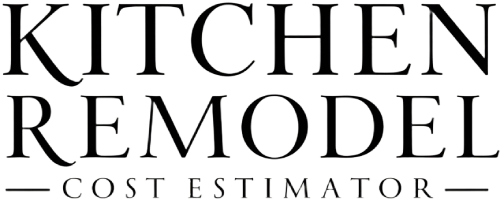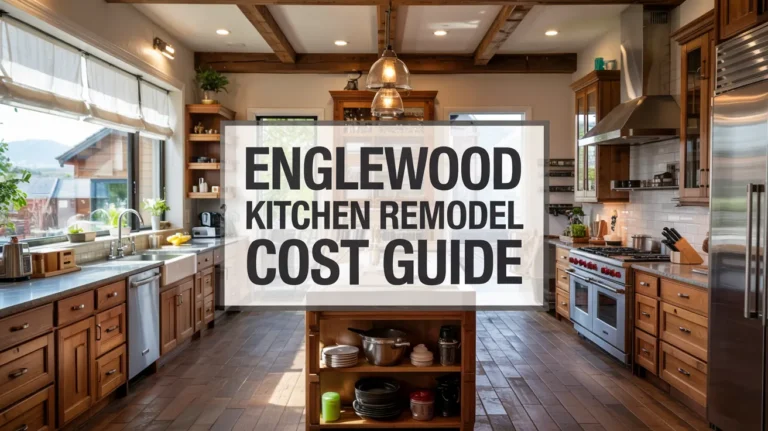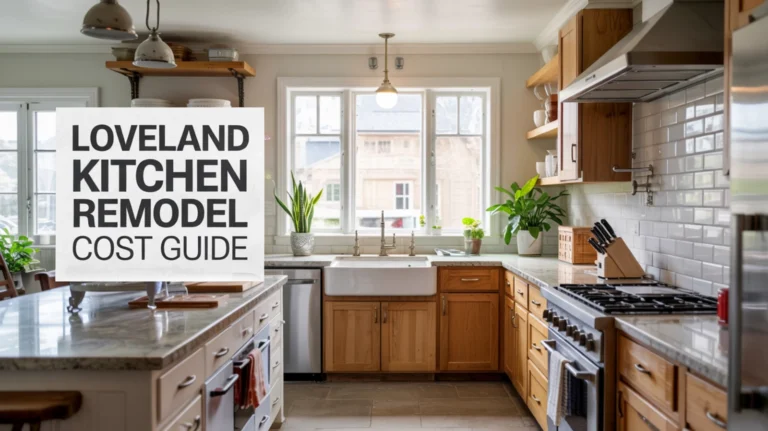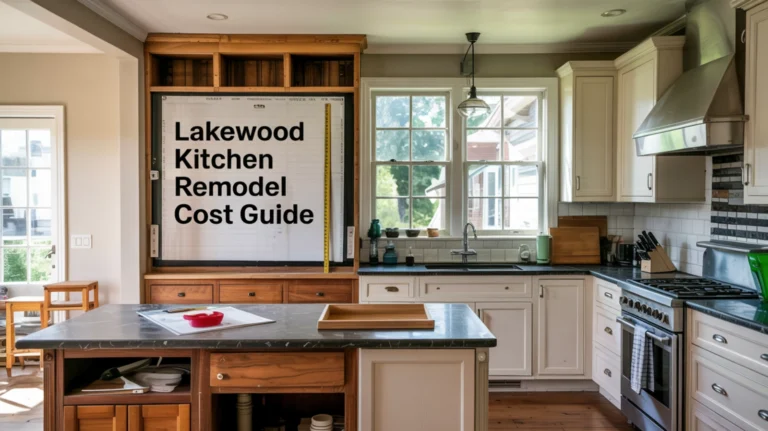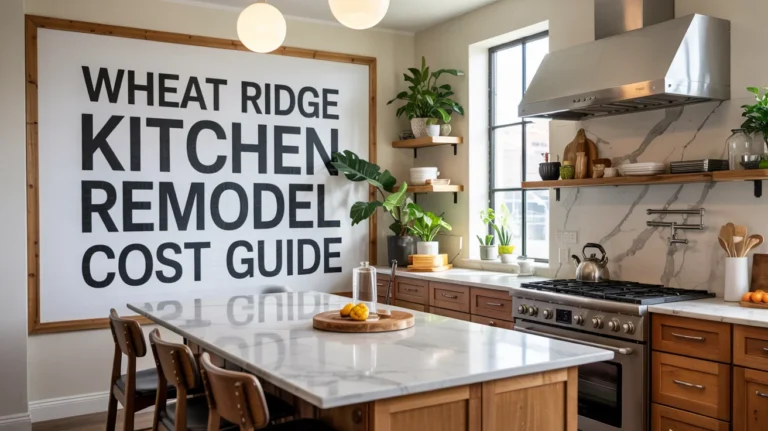Kitchen renovations along Colorado’s Front Range come with unique considerations that impact your bottom line. Arvada’s location nestled between Denver’s urban core and the foothills creates a sweet spot where material costs, labor rates, and permit requirements have their own local flavor. Construction costs here reflect our mountain region premium, but savvy homeowners can still find value by understanding exactly where their dollars go.
So what should you expect to invest in your Arvada kitchen transformation?
The average kitchen remodel cost in Arvada, Colorado ranges from $16,000 to $45,000. Budget remodels may begin at $12,000, while high-end renovations with custom features, upgraded appliances, and layout changes can exceed $60,000 depending on design complexity and material selection.
Kitchen Remodel Cost Estimator for Arvada
Arvada Kitchen Remodel Cost Calculator
Get an estimate for your kitchen renovation based on your specifications.
Estimated Kitchen Remodel Cost
This estimate is based on national averages and may vary based on your location, material availability, contractor rates, and other factors. Prices are estimates only and should be used for planning purposes.
Looking for more accurate costs in your area? Search for location-specific remodel costs.
Cost Benchmarks and Ranges
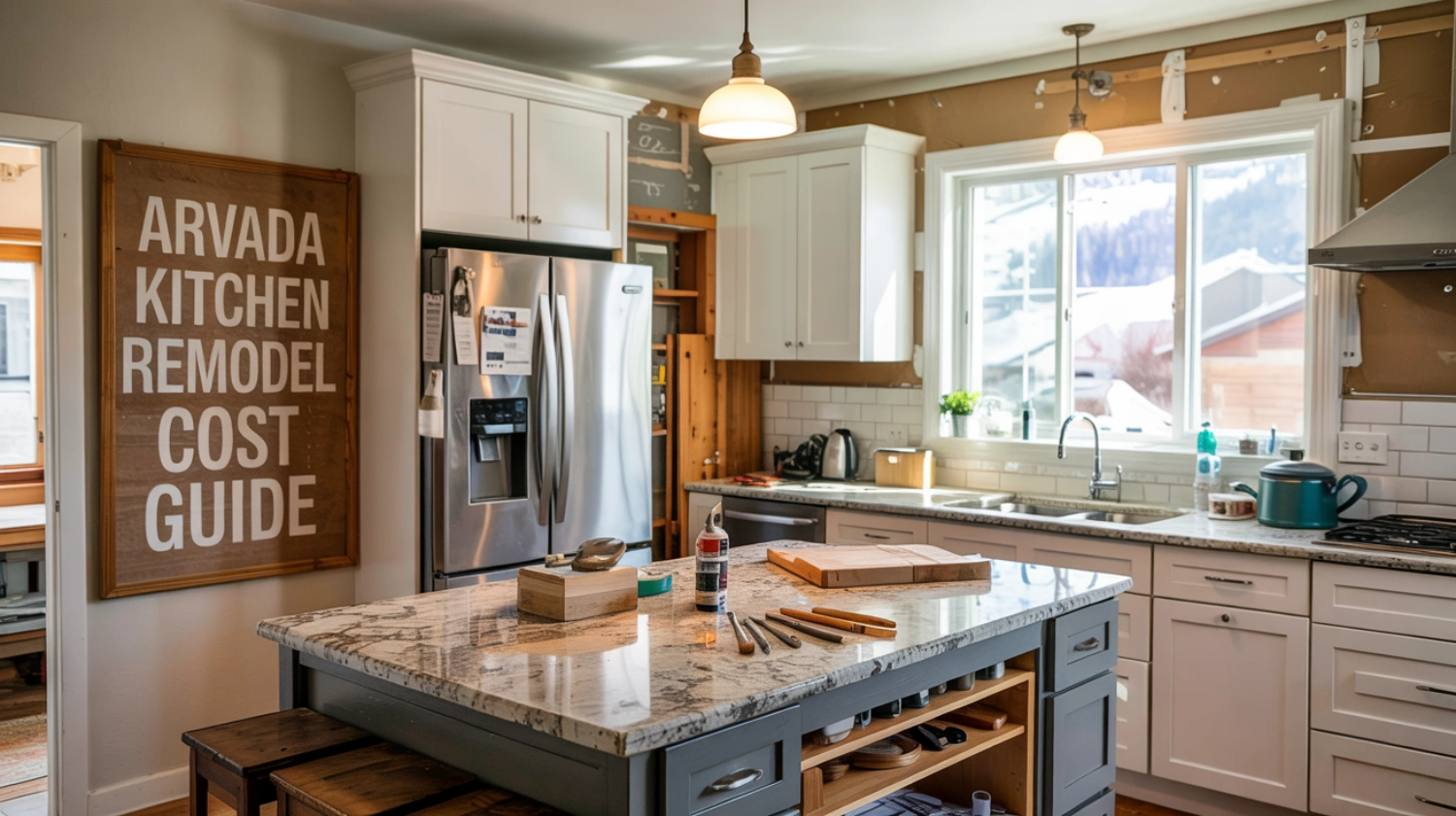
Per Square Foot Kitchen Remodel Costs
Ever wonder why kitchen renovations seem to cost so much more than other home projects? The numbers tell an interesting story.
In Arvada and the broader Denver metro area, expect to invest between $100 and $250 per square foot for kitchen remodeling. Compare that to general house renovations at just $15 to $60 per square foot, and you might feel a bit of sticker shock.
Why the dramatic difference?
It’s all about concentration. Kitchens pack significant infrastructure into a compact space: plumbing lines, electrical work, and high-value finishes all crammed into one relatively small area. That density drives the cost up substantially.
Looking specifically at Denver regional estimates, the range actually widens to $190-$375 per square foot. This broader spectrum reflects everything from basic refreshes to luxury transformations, with material pricing adding another layer of variability.
If you’re considering a simpler update, there’s good news. Lower-end cosmetic refreshes might run closer to $75 per square foot. But if you’re dreaming of comprehensive renovations with layout changes and premium materials, prepare to push toward the upper end of that $100-$250 range.
Project Scope Cost Ranges (Arvada/Denver Area)
Your total investment will vary dramatically based on three critical factors: the scope of work, materials selected, and your kitchen’s size.
Minor/Basic Remodel: $7,000 to $15,000
What can you get at this price point? These projects focus on cosmetic updates like:
- Refacing or painting existing cabinets
- Installing new entry-level appliances
- Adding laminate countertops and vinyl flooring
- Upgrading to a new sink/faucet
- Refreshing with fresh paint
The key cost-saving strategy here is retaining your existing kitchen layout, which minimizes plumbing and electrical work. For perspective, national averages for similar projects run higher, between $24,000 to $27,492.
Mid-Range Remodel: $11,000 to $50,000
Step up to this budget range, and you unlock possibilities like: ● Higher-quality materials (granite or quartz countertops)
- Semi-custom cabinetry or comprehensive refacing
- Energy-efficient appliances
- More durable flooring options (hardwood or tile)
- Enhanced lighting solutions
- Potential for minor layout adjustments
Some estimates push the upper boundary even higher, suggesting averages up to $69,000 nationally for major mid-range projects featuring islands and custom lighting systems.
Upscale/High-End Remodel: $38,000 to $150,000+
Dreaming big? High-end renovations start around $38,000 and can easily exceed $150,000. These transformations often involve:
- Significant layout reconfigurations
- Custom cabinetry throughout
- Premium integrated appliances
- Exotic stone countertops (granite, quartz, marble)
- Custom tile installations
- Designer lighting fixtures
- Premium flooring options
- Potential structural modifications or additions
For these comprehensive, quality-focused renovations, it’s common to invest 10% or more of your home’s total value.
Cost Estimates by Kitchen Size (Denver Area)
How much space are you working with? Your kitchen’s square footage plays a major role in determining your total renovation budget.
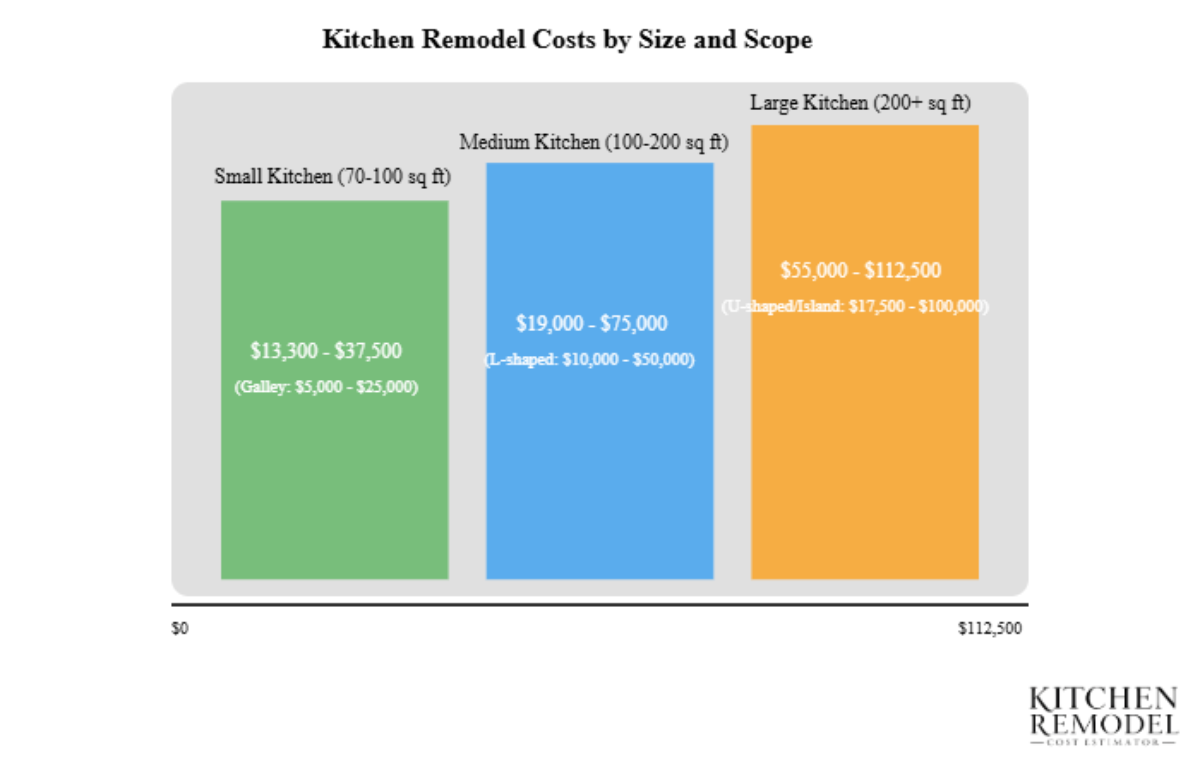
Think about it: more space means more materials, more labor hours, and ultimately, more investment. But how does this break down for different kitchen sizes?
Small Kitchen (70-100 sq. ft.)
Working with a cozy kitchen? Remodeling costs typically fall between $13,300 and $37,500, with the final number depending on your choice of finishes and how extensive the renovation will be.
Galley kitchens, which tend to be on the smaller side, might run you anywhere from $5,000 to $25,000. Their compact, efficient layout can actually help keep costs in check if you’re working with a tight budget.
Medium Kitchen (100-200 sq. ft.)
The middle ground is where many homeowners find themselves, with costs generally ranging from $19,000 to $75,000.
L-shaped kitchens typically fall into this size category. Expect to invest between $10,000 and $50,000 for a standard renovation. That number could climb toward $75,000 if you’re adding or significantly modifying a peninsula.
Large Kitchen (200+ sq. ft.)
If you’re blessed with expansive kitchen space, your remodeling journey typically starts around $55,000 and can easily exceed $112,500.
Why such a substantial jump? Large kitchens offer more possibilities for luxury finishes, expansive layouts, islands, and truly custom designs – all of which come with corresponding price tags.
U-shaped kitchens (requiring ~175 sq. ft. or more) typically cost between $17,500 and $75,000 to renovate. Meanwhile, kitchens featuring islands – often the crown jewel of larger spaces – range from $20,000 to $100,000 depending on complexity and finish selections.
Cost Component Breakdown
Typical Allocation of Budget
Ever wondered exactly where your kitchen remodeling dollars actually go? Understanding how costs typically break down can help you plan more effectively and decide where to splurge versus where to save.
While individual projects will vary based on your priorities, here’s how costs are commonly distributed in the Denver area:
| Item | Budget Percentage | Notes |
|---|---|---|
| Cabinetry & Hardware | 29% | Often the largest single expense category. |
| Installation & Labor | 17% | Covers demo, construction, trades (plumbing, electrical, tiling). |
| Appliances & Ventilation | 14% | Includes fridge, range, dishwasher, microwave, hood, disposal. |
| Countertops | 10% | Material choice significantly impacts this percentage. |
| Flooring | 5-7% | Varies by material (vinyl, tile, hardwood) and area. |
| Lighting & Electrical | 5% | Includes fixtures, wiring, potential panel upgrades. |
| Plumbing & Faucets | 4-6% | Includes sink, faucet, pipe modifications, fixture installation. |
| Backsplash | 5% | Material and coverage area affect cost. |
| Walls & Ceilings | 5% | Drywall repair, texture, paint. |
| Doors & Windows | 4% | Replacement or modification costs. |
| Design Fees | 4% | Professional design services, if utilized. |
| Miscellaneous | 5% | Permits, demolition/removal, unforeseen issues. |
Interestingly, these proportions can shift dramatically based on project scope. One alternative breakdown for a basic/low-end remodel ($45,000 total) suggests Labor (45%), Cabinets (22%), Appliances (11%), Interior Designer (9%), Countertops (7%), Tile (4%), and Sink/Faucet/Paint/Misc (2%).
This highlights an important point: labor costs tend to dominate lower-budget projects when significant professional help is involved.
Key Component Cost Details
Let’s dive deeper into what you’ll pay for the major elements of your kitchen renovation. Understanding these details helps you allocate your budget where it matters most to you.
Cabinetry: The Big-Ticket Item
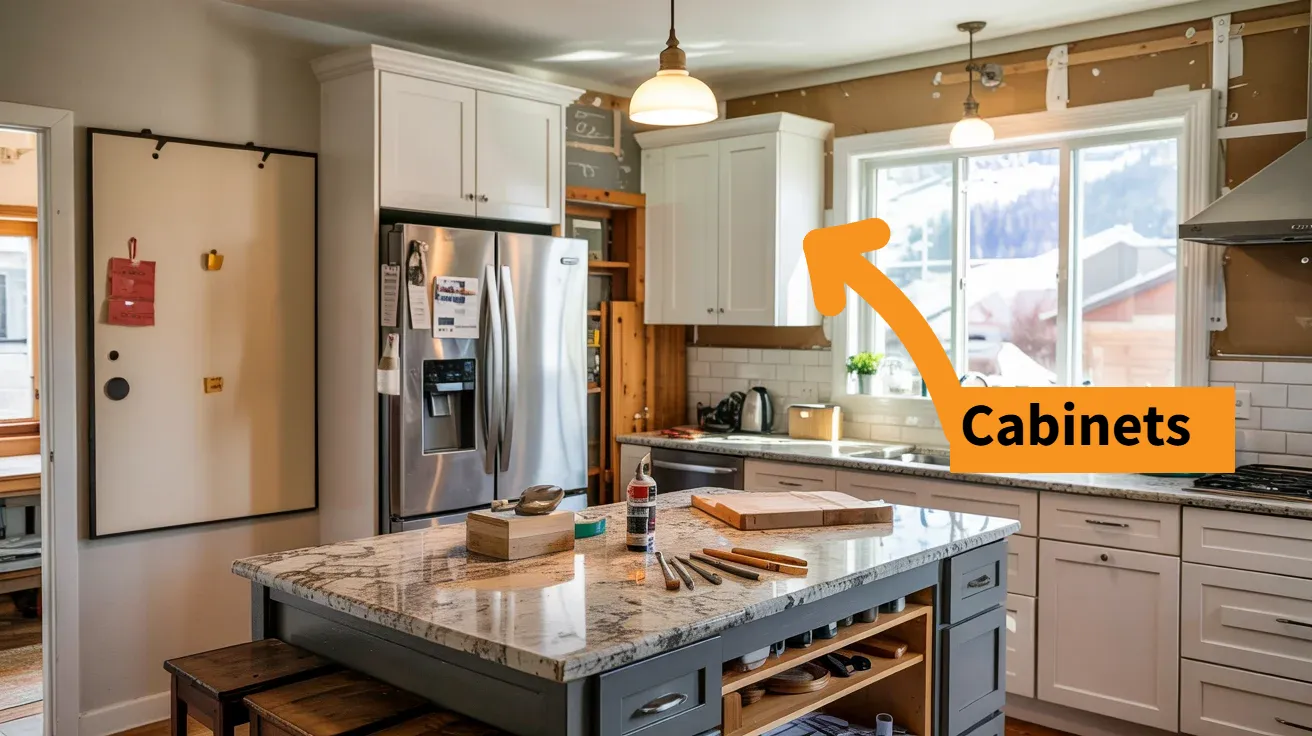
Cabinets represent the largest chunk of your budget, claiming approximately 29% of your total investment. Why so much? They’re essentially furniture—custom-built for your specific space.
Your costs will vary dramatically based on several factors:
- Stock cabinets ($100-$500 per base/wall cabinet)
- Semi-custom options (higher price point)
- Fully custom designs (premium pricing)
- Material choices (wood species, MDF)
- Finish quality
- Hardware and features (soft-close mechanisms, organizers)
Looking to save? Consider refacing your existing cabinets rather than full replacement. It’s significantly more economical.
If you’re shopping locally, Arvada and nearby areas offer several cabinet sources, including JM Kitchen & Bath Design, Tharp Custom Cabinetry, Wedgewood Cabinetry, Fort Collins Cabinet Kings (serving Arvada), Elite Cabinetry & Granite, R&J Cabinetry, The Arvada Flooring Company, and Custom Cabinets 303.
Countertops: Surface Matters
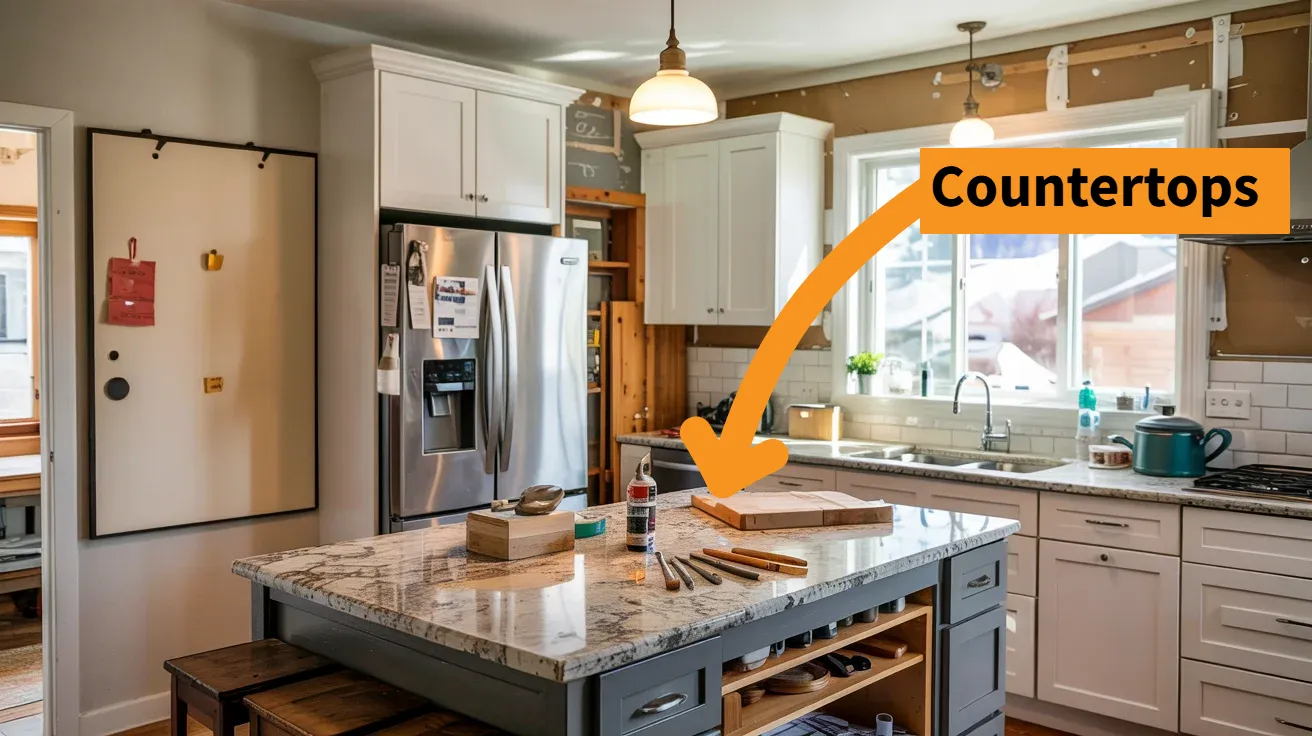
Countertops typically account for about 10% of your budget, but their impact on your kitchen’s look and functionality is enormous.
Material selection drives pricing more than any other factor. Laminate offers the most budget-friendly option, while natural stone (granite, quartzite, marble) and engineered quartz represent popular mid-range to high-end choices.
Beyond the material itself, costs depend on:
- Specific slab selection
- Edge profile complexity
- Number of cutouts needed
- Installation challenges
For Arvada and Denver area sourcing, consider Pioneer Granite and Quartz, Green Acres Granite, YK Stone Center, The Arvada Flooring Company, Front Range Stone Countertops, Granite Liquidators, Rockies Granite, Elite Cabinetry & Granite, Carpet Mill Outlet Stores, and Granite Transformations.
Appliances: Function Meets Form
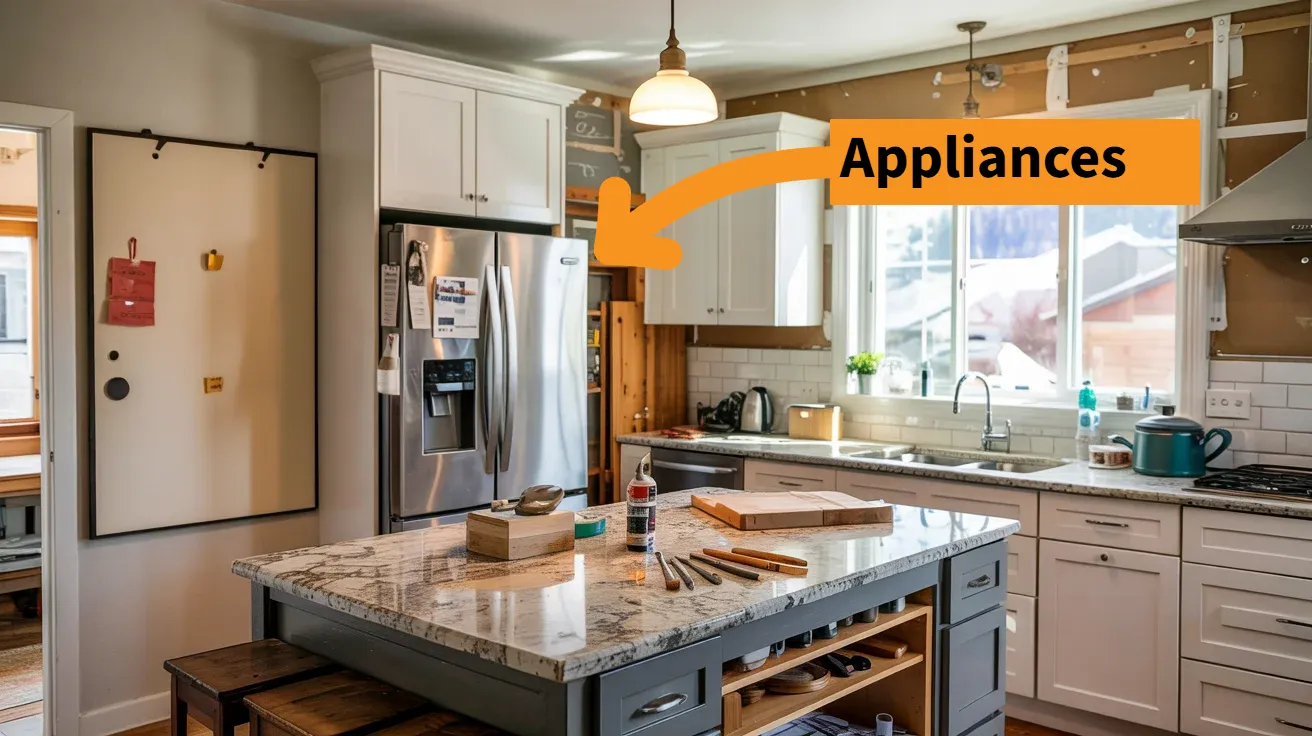
Appliances typically consume about 14% of your total budget. This category shows perhaps the widest possible price range, with basic packages running a few thousand dollars while high-end, integrated, professional-grade setups can reach tens of thousands.
What drives the price disparity? Brand reputation, features, and energy efficiency ratings all play major roles. Energy Star models might cost more upfront but offer long-term utility savings.
Typical individual appliance costs include:
- Refrigerator ($1,000-$3,000)
- Range ($800-$2,000)
- Oven ($750-$2,700)
- Dishwasher ($700-$1,970)
- Cooktop ($500-$1,000)
- Microwave ($290-$870)
- Garbage disposal ($250-$400)
Flooring: The Foundation
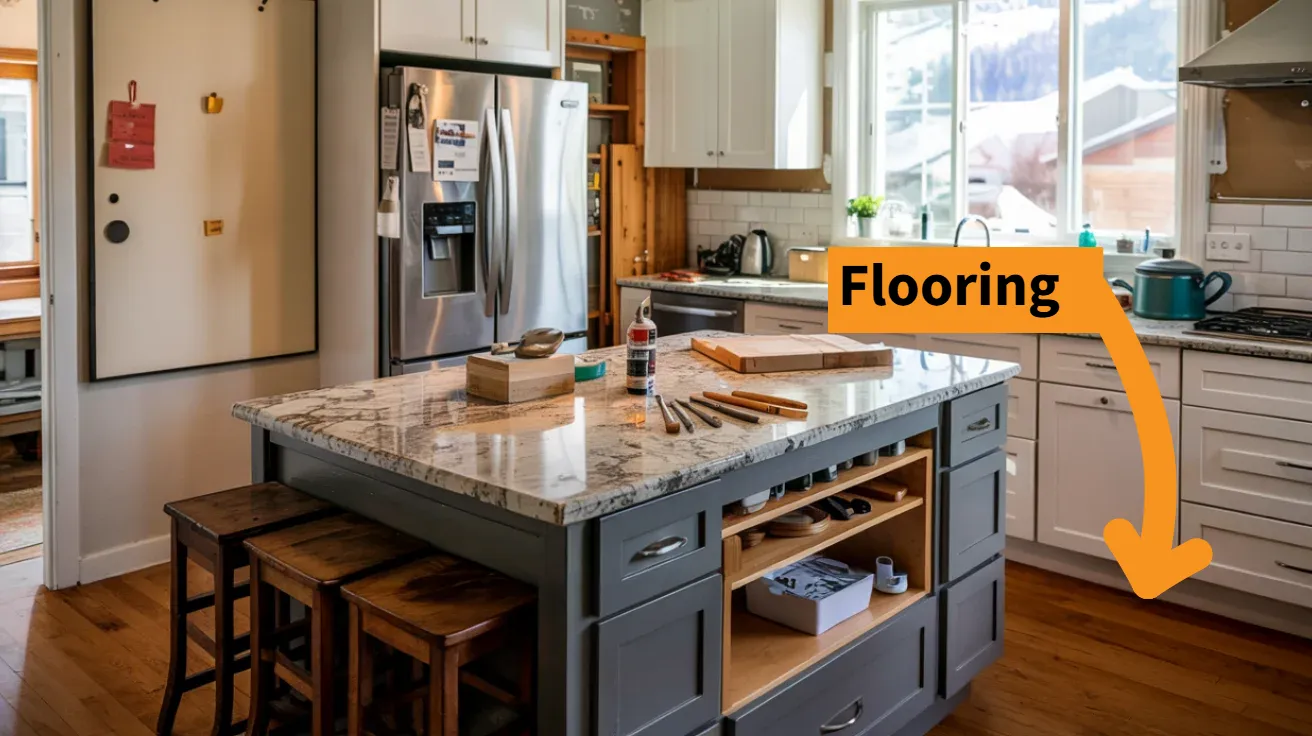
Flooring represents about 5-7% of your total investment, yet it’s literally the foundation of your kitchen’s appearance and functionality.
Material costs vary enormously:
- Vinyl offers affordability ($600-$2,000 for materials in an average kitchen)
- Tile, hardwood, and luxury vinyl plank (LVP) cost more but provide greater durability and aesthetic appeal
Installation costs depend on both the material chosen and the subfloor preparation required.
If you’re shopping for flooring in Arvada or Denver, options include Custom Flooring Specialists, Floor & Decor, Carpet Exchange, The Arvada Flooring Company, Simply Floors, Weaver Carpets, and The Aurora Flooring Store.
Labor: The Hidden Essential
Labor represents a significant portion (approximately 17%) of your budget, potentially climbing even higher (up to 45%) on lower-end projects with extensive professional involvement.
What does this cover? Everything from demolition to installation of cabinets, countertops, flooring, tile, plumbing fixtures, electrical work, drywall, and painting.
Costs vary based on contractor rates, project complexity, and whether your renovation requires modifications to structural elements, plumbing, or electrical systems.
Don’t forget about demolition and removal of existing elements – this can significantly increase labor costs due to the time and specialized disposal requirements involved.
Permits: The Necessary Investment
Permit fees represent a necessary component of your budget, though typically a smaller percentage of your overall investment. In Arvada, these costs are based on project valuation, with specific fees detailed in the next section.
Permitting and Regulatory Requirements
Arvada Permit Process and Fees
Planning your dream kitchen is the fun part. Navigating permits? Not so much. But understanding Arvada’s requirements upfront can save you headaches (and potentially costly corrections) down the road.
Most kitchen remodels in Arvada require a building permit, especially if you’re making structural changes, modifying plumbing, or updating electrical work. The city uses an electronic application process through www.arvadapermits.org.
Here’s an interesting wrinkle: if you’re a homeowner performing work on your own occupied residence, you don’t need a contractor license. However, any professionals you hire must be licensed with the City of Arvada.
What documents will you need?
Your electronic submission must include a complete plan set with:
- Floor plans (scaled, with labeled room uses and dimensions)
- Locations of electrical outlets, fixtures, smoke/CO detectors, plumbing, and appliances
- Window/door sizes and types (with egress window details if applicable)
- Identification of any structural modifications (posts, beams, joists)—these require engineering documentation
- Gas line sizing calculations (if applicable)
- Subcontractor forms (if applicable)
How much will permits cost?
Arvada bases permit fees on the total valuation of your project—essentially the cost of construction. For homeowners doing work themselves, this is often estimated as double the material cost.
The typical fees for an interior remodel include:
- Plan Review Fee: $32.50 (though one specific permit example noted a $37.50 fee)
- Building Permit Fee: Calculated based on project valuation according to Table 18-1 of the City’s Building Fee Schedule
- Use Tax: Calculated as 3.46% of 58% of the job value
The 2025 Building Fee Schedule (Table 18-1) provides the calculation basis for the Building Permit Fee:
| Total Valuation | Fee Calculation |
|---|---|
| $1.00 to $500.00 | $34.00 |
| $501.00 to $2,000.00 | $34.00 for first $500 + $3.05 per additional $100 |
| $2,001.00 to $25,000.00 | $79.75 for first $2,000 + $14.00 per additional $1,000 |
| $25,001.00 to $50,000.00 | $401.75 for first $25,000 + $10.10 per additional $1,000 |
| $50,001.00 to $100,000.00 | $654.25 for first $50,000 + $7.00 per additional $1,000 |
| $100,001.00 to $500,000.00 | $1,004.25 for first $100,000 + $5.60 per additional $1,000 |
| $500,001.00 to $1,000,000.00 | $3,244.25 for first $500,000 + $4.85 per additional $1,000 |
| $1,000,001.00 and up | $5,669.25 for first $1,000,000 + $3.45 per additional $1,000 |
Want to get a rough estimate before you apply? An online fee calculator is available through the city. For context, one example permit for a 250 sq ft kitchen remodel involving wall removal and cabinet replacement showed total fees of $702.27, including permit fee ($261.75), use tax ($301.02), plan review ($37.50), and Elec/HVAC/Plumb fees ($102.00).
Need to contact someone directly?
City of Arvada Building Services 8101 Ralston Road, Arvada, CO 80002 Phone: 720-898-7620 Permit Website: www.arvadapermits.org
Adopted Building Codes and Standards
Why do building codes matter for your kitchen remodel? Because they ensure your beautiful new space isn’t just Instagram-worthy—it’s also safe, functional, and built to last.
Arvada enforces building codes based on internationally recognized standards, with local amendments and specific design criteria tailored to Colorado’s unique conditions.
Adopted Codes
2018 International Residential Code (IRC): This is the primary code governing construction of one- and two-family dwellings, including your kitchen remodel. Arvada adopted the 2018 IRC including Appendices A, B, C, F, G, H, J, K, M, N, and O. The IRC specifies requirements for electrical outlets (including GFCI protection and spacing), lighting, and ventilation.
2023 National Electrical Code (NEC): This code governs all electrical installations in your kitchen, from outlet placement to lighting requirements.
2018 International Plumbing Code (IPC): Covers all plumbing systems, which is particularly important for kitchen sink, dishwasher, and refrigerator connections.
2018 International Mechanical Code (IMC): Regulates mechanical systems, including your kitchen ventilation requirements.
2018 International Fuel Gas Code (IFGC): Essential if your kitchen includes gas appliances like ranges or cooktops.
2018 International Fire Code (IFC): Sets standards relevant to fire safety systems and requirements.
Key Arvada Design Criteria
These criteria might not directly impact your kitchen renovation, but they’re important for understanding why certain construction standards exist:
- Frost Depth: 36 inches
- Snow Load: 30 psf (ground and roof)
- Wind Speed: 136 mph Vult (East of Hwy 93), 150 mph Vult (West of Hwy 93)
- Seismic Design: Governed by IRC/IBC provisions based on geographic location
- Climate Zone: Important for energy efficiency requirements
ASTM Standards for Materials
What makes a material suitable for kitchen use? Industry standards provide the answer.
Material performance and safety are governed by standards from organizations like ASTM International. Specifying materials that meet relevant ASTM standards ensures durability, safety, and suitability for kitchen environments.
Tile (Ceramic/Porcelain)
| Property Tested | Key Standard(s) | Significance for Kitchen Use |
|---|---|---|
| Water Absorption | ASTM C373 / ISO 10545-3 | Determines suitability for wet areas. Porcelain requires ≤0.5% absorption (Extremely Dense). |
| Abrasion Resistance | ASTM C1027 (PEI Rating) | Measures wear resistance for floors. PEI III (Moderate Traffic) is recommended for residential kitchen floors. PEI IV/V for heavier traffic. |
| Slip Resistance (DCOF) | ANSI A326.3 | Measures friction when wet. ≥0.42 (Wet) required for level interior floors walked on when wet (like kitchens). |
| Breaking Strength | ASTM C648 / ISO 10545-4 | Measures load-bearing capacity, important for floors. |
| Chemical Resistance | ASTM C650 / ISO 10545-13 | Measures resistance to household chemicals and cleaning agents. |
| Stain Resistance | ISO 10545-14 | Measures resistance to staining agents. |
Natural Stone (Granite, Marble, Quartzite, Slate, Travertine)
| Property Tested | Key Standard(s) | Significance for Kitchen Use |
|---|---|---|
| Absorption | ASTM C97 | Indicates porosity and susceptibility to staining. Lower absorption is preferred for countertops. |
| Compressive Strength | ASTM C170 | Measures resistance to crushing forces, indicating durability under load. |
| Flexural Strength | ASTM C880 (General), C120 (Slate) | Measures bending strength (Modulus of Rupture), important for countertop overhangs and unsupported spans. |
| Abrasion Resistance | ASTM C241 / C1353 | Indicates resistance to scratching and wear from use and cleaning. |
| Slip Resistance | ASTM C1028 (Static) | Measures slip potential if used for flooring. (Note: DCOF via ANSI A326.3 is the current standard for walking surfaces). |
Cement Board (Underlayment)
| Property Tested | Key Standard(s) | Significance for Kitchen Use |
|---|---|---|
| Water Absorption | ASTM C473 | Low absorption inhibits mold growth, crucial for wet areas like under tile floors or countertops. |
| Mold Resistance | ASTM D3273 / ASTM G21 | High resistance prevents mold growth behind tile. |
Tile Installation
| Property Tested | Key Standard(s) | Significance for Kitchen Use |
|---|---|---|
| Adhesive Contact | ANSI A108.5 | Specifies minimum adhesive coverage (80% dry areas, 95% wet/exterior) for proper bonding. |
| Movement Joints | TCNA Handbook (EJ171) / ASTM C920 | Required to accommodate structural movement and prevent tile cracking. Perimeter gaps and field joints (every 20-25 ft interior) filled with sealant. |
Note: Specific ASTM standards exist for different stone types (e.g., ASTM C615 for Granite, C503 for Marble, C616 for Quartz-Based, C629 for Slate, C1527 for Travertine) which define minimum physical property requirements for classification.
Return on Investment (ROI) Analysis
ROI Benchmarks for Denver/Mountain Region
When planning a kitchen remodel, there’s an elephant in the room that many homeowners prefer to ignore: Will you get your money back if you sell?
Return on investment is measured as the percentage of your remodeling cost that you’ll recoup when selling your home. It varies based on project scope, market conditions, and even geographic region.
While national data provides a general baseline, regional information better captures the nuances of your local market. One consistent trend? Exterior projects typically show higher ROI due to their immediate impact on curb appeal.
Recent Cost vs. Value reports reveal some fascinating patterns:
Minor Kitchen Remodel: The ROI Champion
If you’re remodeling with future resale in mind, this is your sweet spot. Minor kitchen updates consistently offer the highest ROI among interior projects nationwide.
The 2024 national average showed an exceptional 96.1% cost recouped. That’s right—you’re recovering almost everything you spend! Other sources confirm this figure, citing 96% ROI.
This represents a significant jump from the 2023 national average of 85.7% and aligns with strong historical performance (including 97.4% cited for 2020).
What’s the takeaway? Modest, targeted updates focused on refreshing surfaces and select appliances provide substantial perceived value relative to their cost.
Major Mid-Range Kitchen Remodel: The Middle Ground
Ready for a sobering drop? The ROI for more comprehensive remodels falls dramatically. The national average showed just 49.5% cost recouped. This continues a pattern seen in 2023 (41.8% national ROI).
The regional picture gets interesting here. One source citing the Cost vs. Value report indicates a 67.2% ROI for major mid-range remodels in the Mountain region (including Colorado). This suggests local buyers value these updates more than the national average.
However, another source referencing the same report shows a 51% ROI for extensive remodels in the region—closer to the national figure. This discrepancy highlights the variability in regional reporting or definitions.
Major Upscale Kitchen Remodel: The Luxury Indulgence
High-end, discretionary projects yield the lowest financial returns. The national average showed just 38.0% cost recouped, a slight improvement from 31.7% in 2023.
These projects prioritize homeowner enjoyment and customization over resale value maximization. They’re about the experience, not the investment.
Other data points suggest general kitchen remodel ROI between 57.4% and 62.1%, while Zillow data indicated homes listed with “renovated kitchen” in Colorado sold for 2.5% more than expected.
Here’s a clear pattern emerging from multi-year data: financial efficiency (cost recouped at resale) diminishes as project scope and cost escalate from minor cosmetic updates to major structural and high-end renovations.
| Remodel Scope | National ROI % | Denver/Mountain Region ROI % | Notes |
|---|---|---|---|
| Minor Kitchen Remodel | 96.1% | Not Explicitly Isolated | Consistently high ROI nationally. Regional data point unavailable in snippets, but likely strong based on national trend. |
| Major Mid-Range Remodel | 49.5% | 51% – 67.2% | National figure is 49.5%. Regional reports show 51% for extensive remodel and 67.2% in other sources. Discrepancy highlights need for careful regional data review. |
| Major Upscale Remodel | 38.0% | Not Explicitly Stated | Lowest ROI, reflecting discretionary nature of high-end projects. |
Conclusion
Kitchen remodeling in Arvada boils down to three critical factors: scope, size, and materials.
Expect to invest $100-$250 per square foot. Minor refreshes start around $7,000, while luxury transformations can exceed $150,000.
Your biggest expenses? Cabinetry takes the lead, followed by labor, appliances, and countertops.
The financial equation is clear: minor updates deliver the highest ROI (96% nationally), while upscale renovations recoup just 38%. But the latter offers something no spreadsheet can capture—a kitchen perfectly tailored to how you live.
Permits and building codes aren’t just red tape—they’re guarantees your beautiful new space is also safe and durable.
The right investment isn’t about averages. It’s about your timeline in the home and which kitchen features matter most in your daily life.
